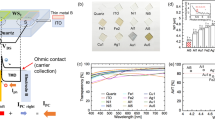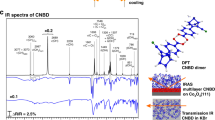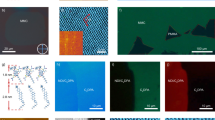Abstract
The limitations of the bulk semiconductors currently used in electronic devices—rigidity, heavy weight and high costs—have recently shifted the research efforts to two-dimensional atomic crystals1 such as graphene2 and atomically thin transition-metal dichalcogenides3,4. These materials have the potential to be produced at low cost and in large areas, while maintaining high material quality. These properties, as well as their flexibility, make two-dimensional atomic crystals attractive for applications such as solar cells or display panels. The basic building blocks of optoelectronic devices are p–n junction diodes, but they have not yet been demonstrated in a two-dimensional material. Here, we report a p–n junction diode based on an electrostatically doped5 tungsten diselenide (WSe2) monolayer. We present applications as a photovoltaic solar cell, a photodiode and a light-emitting diode, and obtain light–power conversion and electroluminescence efficiencies of ∼0.5% and ∼0.1%, respectively. Given recent advances in the large-scale production of two-dimensional crystals6,7, we expect them to profoundly impact future developments in solar, lighting and display technologies.
This is a preview of subscription content, access via your institution
Access options
Subscribe to this journal
Receive 12 print issues and online access
$259.00 per year
only $21.58 per issue
Buy this article
- Purchase on Springer Link
- Instant access to full article PDF
Prices may be subject to local taxes which are calculated during checkout




Similar content being viewed by others
References
Novoselov, K. S. et al. Two-dimensional atomic crystals. Proc. Natl Acad. Sci. USA 102, 10451–10453 (2005).
Novoselov, K. S. et al. Electric field effect in atomically thin carbon films. Science 306, 666–669 (2004).
Radisavljevic, B., Radenovic, A., Brivio, J., Giacometti, V. & Kis, A. Single-layer MoS2 transistors. Nature Nanotech. 6, 147–150 (2011).
Wang, Q. H., Kalantar-Zadeh, K., Kis, A., Coleman, J. N. & Strano, M. S. Electronics and optoelectronics of two-dimensional transition metal dichalcogenides. Nature Nanotech. 7, 699–712 (2012).
Gabor, N. M., Zhong, Z., Bosnick, K., Park, J. & McEuen, P. L. Extremely efficient multiple electron–hole pair generation in carbon nanotube photodiodes. Science 325, 1367–1371 (2009).
Bae, S. et al. Roll-to-roll production of 30-inch graphene films for transparent electrodes. Nature Nanotech. 5, 574–578 (2010).
Liu, K-K. et al. Growth of large-area and highly crystalline MoS2 thin layers on insulating substrates. Nano Lett. 12, 1538–1544 (2013).
Stander, N., Huard, B. & Goldhaber-Gordon, D. Evidence for Klein tunneling in graphene p–n junctions. Phys. Rev. Lett. 102, 026807 (2009).
Pospischil, A. et al. CMOS-compatible graphene photodetector covering all optical communication bands. Nature Photon. 7, 892–896 (2013).
Wang, X., Zhi, L. & Müllen, K. Transparent, conductive graphene electrodes for dye-sensitized solar cells. Nano Lett. 8, 323–327 (2008).
Han, T-H. et al. Extremely efficient flexible organic light-emitting diodes with modified graphene anode. Nature Photon. 6, 105–110 (2012).
Britnell, L. et al. Strong light–matter interactions in heterostructures of atomically thin films. Sci. Express 340, 1311–1314 (2013).
Podzorov, V., Gershenson, M. E., Kloc, Ch., Zeis, R. & Bucher, E. High-mobility field-effect transistors based on transition metal dichalcogenides. Appl. Phys. Lett. 84, 3301–3303 (2004).
Fang, H. et al. High-performance single layered WSe2 p-FETs with chemically doped contacts. Nano Lett. 12, 3788–3792 (2012).
Liu, W. et al. Role of metal contacts in designing high-performance monolayer n-type WSe2 field effect transistors. Nano Lett. 13, 1983–1990 (2013).
Mak, K. F., Lee, C., Hone, J., Shan, J. & Heinz, T. F. Atomically thin MoS2: a new direct-gap semiconductor. Phys. Rev. Lett. 105, 115409 (2009).
Splendiani, A. et al. Emerging photoluminescence in monolayer MoS2 . Nano Lett. 10, 1271–1275 (2010).
Zhang, Y. J., Ye, J. T., Yomogida, Y., Takenobu, T. & Iwasa, Y. Formation of a stable p–n junction in a liquid-gated MoS2 ambipolar transistor. Nano Lett. 13, 3023–3028 (2013).
Tonndorf, P. et al. Photoluminescence emission and Raman response of monolayer MoS2, MoSe2, and WSe2 . Opt. Express 21, 4908–4916 (2013).
Das, S., Chen, H-Y., Penumatcha, A. V. & Appenzeller, J. High performance multilayer MoS2 transistors with scandium contacts. Nano Lett. 13, 100–105 (2013).
Zhang, Y., Ye, J., Matsuhashi, Y. & Iwasa, Y. Polymer ambipolar MoS2 thin flake transistors. Nano Lett. 13, 1983–1990 (2013).
Radosavljević, M., Freitag, M., Thadani, K. V. & Johnson, A. T. Nonvolatile molecular memory elements based on ambipolar nanotube field effect transistors. Nano Lett. 2, 761–764 (2002).
Kim, W. et al. Hysteresis caused by water molecules in carbon nanotube field-effect transistors. Nano Lett. 3, 193–198 (2003).
Das, S. & Appenzeller, J. WSe2 field effect transistors with enhanced ambipolar characteristics. Appl. Phys. Lett. 103, 103501 (2013).
Fontana, M. et al. Electron–hole transport and photovoltaic effect in gated MoS2 Schottky junctions. Sci. Rep. 3, 1634 (2013).
Späh, R., Elrod, U., LuxSteiner, M., Bucher, E. & Wagner, S. pn junctions in tungsten diselenide. Appl. Phys. Lett. 43, 79–81 (1983).
Sundaram, R. S. et al. Electroluminescence in single layer MoS2 . Nano Lett. 13, 1416–1421 (2013).
Chen, J. et al. Bright infrared emission from electrically induced excitons in carbon nanotubes. Science 310, 1171–1174 (2005).
Ross, J. S. et al. Electrical control of neutral and charged excitons in a monolayer semiconductor. Nature Commun. 4, 1474 (2013).
Mak, K. F. et al. Tightly bound trions in monolayer MoS2 . Nature Mater. 12, 207–211 (2013).
Gong, Z. et al. Magnetoelectric effects and valley controlled spin quantum gates in transition metal dichalcogenide bilayers. Nature Commun. 4, 2053 (2013).
Baugher, B. W. H., Churchill, H. O. H., Yafang, Y. & Jarillo-Herrero, P. Optoelectronic devices based on electrically tunable p–n diodes in a monolayer dichalcogenide. Nature Nanotech. http://dx.doi.org/10.1038/nnano.2014.25 (2014).
Ross, J. S. et al. Electrically tunable excitonic light-emitting diodes based on monolayer WSe2 p–n junctions. Nature Nanotech. http://dx.doi.org/10.1038/nnano.2014.26 (2014).
Acknowledgements
The authors thank K. Unterrainer for encouragement, M. Brandstetter, M. Krall and W. Schrenk for technical assistance and E. Bertagnolli for providing access to a Raman spectrometer. The research leading to these results has received funding from the Austrian Science Fund FWF (START Y-539) and the European Union Seventh Framework Programme (grant agreement no. 604391 Graphene Flagship).
Author information
Authors and Affiliations
Contributions
T.M. conceived the experiment. A.P. fabricated the devices and carried out the measurements. M.F. contributed to sample fabrication. A.P. and M.F. built the experimental set-ups. A.P. and T.M. analysed the data. T.M. prepared the manuscript. All authors discussed the results and commented on the manuscript.
Corresponding author
Ethics declarations
Competing interests
The authors declare no competing financial interests.
Supplementary information
Supplementary information
Supplementary information (PDF 744 kb)
Rights and permissions
About this article
Cite this article
Pospischil, A., Furchi, M. & Mueller, T. Solar-energy conversion and light emission in an atomic monolayer p–n diode. Nature Nanotech 9, 257–261 (2014). https://doi.org/10.1038/nnano.2014.14
Received:
Accepted:
Published:
Issue Date:
DOI: https://doi.org/10.1038/nnano.2014.14
This article is cited by
-
Reconfigurable logic and in-sensor encryption operations in an asymmetrically tunable van der Waals heterostructure
Nano Research (2024)
-
Modulating p-type doping of two dimensional material palladium diselenide
Nano Research (2024)
-
Lead halide perovskite sensitized WSe2 photodiodes with ultrahigh open circuit voltages
eLight (2023)
-
Contact-engineered reconfigurable two-dimensional Schottky junction field-effect transistor with low leakage currents
Nature Communications (2023)
-
Interface engineering of charge-transfer excitons in 2D lateral heterostructures
Nature Communications (2023)



